
Super Mario Kart is a kart racing game developed and published by Nintendo for the Super Nintendo Entertainment System (SNES). The first game in the Mario Kart series, it was released in Japan and North America in 1992, and in Europe the following year in 1993. Selling 8.76 million copies worldwide, the game went on to become the fourth best-selling SNES game of all time. Super Mario Kart was re-released on the Wii's Virtual Console in 2009, on the Wii U's Virtual Console in 2013, and on the New Nintendo 3DS's Virtual Console in 2016. Nintendo re-released Super Mario Kart in 2017 as part of the company's Super NES Classic Edition.
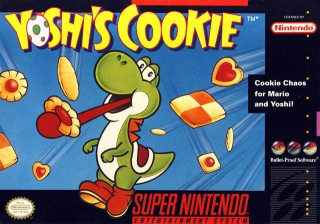
Yoshi's Cookie is a 1992 tile-matching puzzle video game developed by Tose and published by Nintendo for the NES and Game Boy platforms in 1992. A Super NES version was released the following year, developed and published by Bullet-Proof Software.
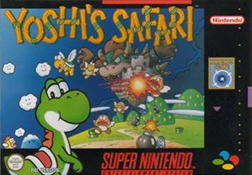
Yoshi's Safari is a 1993 light gun shooter developed and published by Nintendo for its Super Nintendo Entertainment System (SNES). It is the only Mario franchise game to feature first-person shooter gameplay and requires the SNES's Super Scope light gun. As Mario and his pet dinosaur Yoshi, the player embarks on a quest to save the kingdom of Jewelry Land from Bowser and his Koopalings, who have kidnapped its rulers and stolen 12 gems. The game features 12 levels in which the player shoots enemies like Goombas and Koopas, and collects power-ups and coins. At the end of each level, the player engages in a boss fight with an enemy, a Koopaling, or Bowser. Nintendo commissioned its R&D1 department to develop Yoshi's Safari in response to the waning popularity of the Super Scope. Yoshi's Safari was the first Super Scope title to use the SNES's Mode 7 graphics mode, and the future of the peripheral depended on the game's performance.
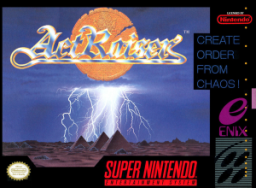
ActRaiser is a 1990 hybrid platformer, god game, and city-building game with light action RPG elements for the Super Nintendo Entertainment System developed by Quintet and published by Enix, combining traditional side-scrolling platforming with urban planning god game sections. A sequel, ActRaiser 2, was released for the Super NES in 1993. In 2007, ActRaiser became available on the Wii's Virtual Console download service in Europe, North America, and Japan. A version of the game was also released for European mobile phones in 2004. A high-definition remaster, ActRaiser Renaissance, was released for several platforms in 2021.
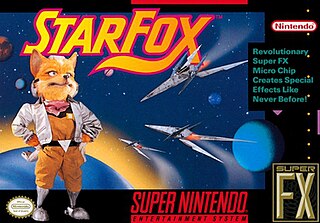
Star Fox, known as Starwing in PAL regions, is a rail shooter video game developed by Nintendo and Argonaut Software and published by Nintendo for the Super Nintendo Entertainment System. The first game in the Star Fox series, the story follows Fox McCloud and the rest of the Star Fox team defending their homeworld of Corneria against the invading forces of Andross.
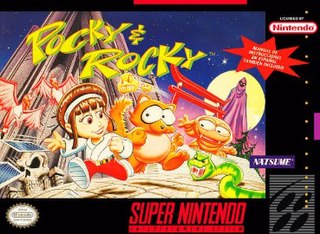
Pocky & Rocky is a 1992 scrolling shooter video game developed and published by Natsume for the Super Nintendo Entertainment System. It is the sequel to Taito's 1986 arcade game KiKi KaiKai. Pocky & Rocky follows the adventures of a young Shinto shrine maiden, Pocky, and her new tanuki companion, Rocky, as they attempt to save a group of goblins from evil forces. Gameplay takes place from a top-down perspective and features both single-player and cooperative modes.

Tiny Toon Adventures is a platform video game for the NES. It was developed and published by Konami and released in 1991. It is the first Tiny Toon Adventures video game to be released for a video game console.

Super Street Fighter II: The New Challengers is a competitive fighting game produced by Capcom and originally released as an arcade game in 1993. It is the fourth game in the Street Fighter II sub-series of Street Fighter games, following Street Fighter II: Hyper Fighting. It refines and balances the existing character roster from the previous versions, and introduces four new characters. It is the first game on Capcom's CP System II hardware, with more sophisticated graphics and audio over the original CP System hardware used in previous versions of Street Fighter II.

Kirby's Adventure is a 1993 platform game developed by HAL Laboratory and published by Nintendo for the Nintendo Entertainment System (NES). It is the second game in the Kirby series after Kirby's Dream Land (1992) on the Game Boy and the first to include the Copy Ability, which allows the main character Kirby to gain new powers by eating certain enemies. The game centers around Kirby traveling across Dream Land to repair the Star Rod after King Dedede breaks it apart and gives the pieces to his minions.

Kirby Super Star, released as Kirby's Fun Pak in PAL regions, is an anthology platform video game developed by HAL Laboratory and published by Nintendo for the Super Nintendo Entertainment System in 1996. It is part of the Kirby series of video games by HAL Laboratory. The game was advertised as a compilation featuring eight games: seven short subsections with the same basic gameplay, and two minigames.
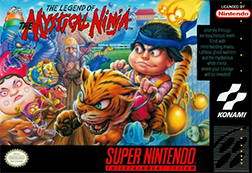
The Legend of the Mystical Ninja, known as Ganbare Goemon: Yukihime Kyūshutsu Emaki in Japan, is an action-adventure game by Konami, and was released for the Super Nintendo Entertainment System in 1991. It was also ported to the Game Boy Advance along with Ganbare Goemon 2: Kiteretsu Shōgun Magginesu only in Japan.
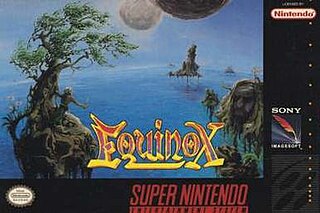
Equinox is an action adventure puzzle video game developed by Software Creations and published by Sony Imagesoft for the Super NES. A sequel to Solstice (1990) for the Nintendo Entertainment System, Equinox depicts Glendaal saving his father Shadax, the previous game's playable character, from the imprisonment of Sonia, Shadax's apprentice. The player acts as Glendaal, exploring 458 rooms in eight underground dungeons. The player collects 12 blue orb tokens while solving puzzles, killing enemies, collecting keys, navigating platforms and blocks, and battling bosses. It continues Solstice's isometric puzzle game style, with greater emphasis on action adventure and Mode 7 overworld map.

Mega Man X is a platform game developed and published by Capcom for the Super Nintendo Entertainment System. It was the first Mega Man game for the 16-bit console and the first game in the Mega Man X series, a spin-off to the original Mega Man series that began on the Super NES's predecessor, the Nintendo Entertainment System. Mega Man X was released in Japan on December 17, 1993 and was released in both North America and Europe the following year. Taking place a century after the original Mega Man series, Mega Man X is set in a futuristic world populated by both humans and "Reploids", robots capable of thinking, feeling, and growing like their human creators. Because of these complex attributes, many Reploids are prone to destructive, renegade activity and are thereafter referred to as "Mavericks". The plot of the game follows the protagonist X, an android member of a military task force called the "Maverick Hunters". With the help of his partner Zero, X must thwart the plans of Sigma, a powerful Maverick leader wishing to bring about human extinction.

Super Ghouls 'n Ghosts, known in Japan as Super Demon World Village, is a platform video game developed and published by Capcom for the Super Nintendo Entertainment System in 1991. As the third game in the Ghosts 'n Goblins series and the first not to be released for the arcade, it again depicts knight Arthur saving Princess Guinevere and the kingdom from Emperor Sardius, who has cast a spell that has revived the Ghoul Realm.

Tiny Toon Adventures: Wacky Sports Challenge, is a Sports party video game. The game was released in 1994 for the Super Nintendo Entertainment System and developed and published by Konami. The video game is based on the American children’s television series, Tiny Toon Adventures. It is one of the few SNES games to feature an SNES Multitap as a useable controller.

DinoCity is a platform video game developed and published by Irem Corporation for the Super Nintendo Entertainment System.

Super Bomberman is an action, maze game, part of the Bomberman series, released for the Super NES in 1993. It is the first in the series to be released in Europe keeping the Bomberman title instead of being called Dynablaster or Eric and the Floaters.

Street Fighter II Turbo: Hyper Fighting is a competitive fighting game released by Capcom for arcades in 1992. It is the third arcade version of Street Fighter II, part of the Street Fighter franchise, following Street Fighter II: Champion Edition, and was initially released as an enhancement kit for that game. Released less than a year after the previous installment, Turbo introduced a faster playing speed and new special moves for certain characters, as well as further refinement to the character balance.

Sparkster is a side-scrolling platform game developed and published by Konami for the Super Nintendo Entertainment System. The game, the only one in the series to be released on a Nintendo console, was directed by Hideo Ueda and released in 1994 for Japan in September, for North America in October, and for Europe in 1994.

Super Mario All-Stars is a 1993 compilation of platform games for the Super Nintendo Entertainment System (SNES). It contains remakes of Nintendo's four Super Mario games released for the Nintendo Entertainment System (NES) and the Famicom Disk System: Super Mario Bros. (1985), Super Mario Bros.: The Lost Levels (1986), Super Mario Bros. 2 (1988), and Super Mario Bros. 3 (1988). As in the original games, players control the Italian plumber Mario and his brother Luigi through themed worlds, collecting power-ups, avoiding obstacles, and finding secrets. The remakes feature updated graphics—including the addition of parallax scrolling—and music, modified game physics, a save feature, and bug fixes.




















